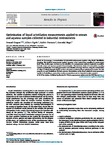Application of nuclear techniques to environmental plastics research
| dc.contributor.author | Lanctot, CM | |
| dc.contributor.author | Al-Sid-Cheikh, M | |
| dc.contributor.author | Catarino, AI | |
| dc.contributor.author | Cresswell, T | |
| dc.contributor.author | Danis, B | |
| dc.contributor.author | Karapanagioti, HK | |
| dc.contributor.author | Mincer, T | |
| dc.contributor.author | Oberhansli, F | |
| dc.contributor.author | Swarzenski, P | |
| dc.contributor.author | Tolosa, I | |
| dc.contributor.author | Metian, M | |
| dc.date.accessioned | 2018-12-19T12:21:53Z | |
| dc.date.issued | 2018-12 | |
| dc.identifier.issn | 0265-931X | |
| dc.identifier.issn | 1879-1700 | |
| dc.identifier.uri | http://hdl.handle.net/10026.1/13093 | |
| dc.description.abstract |
Plastic pollution is ubiquitous in aquatic environments and its potential impacts to wildlife and humans present a growing global concern. Despite recent efforts in understanding environmental impacts associated with plastic pollution, considerable uncertainties still exist regarding the true risks of nano- and micro-sized plastics (<5 mm). The challenges faced in this field largely relate to the methodological and analytical limitations associated with studying plastic debris at low (environmentally relevant) concentrations. The present paper highlights how radiotracing techniques that are commonly applied to trace the fate and behaviour of chemicals and particles in various systems, can contribute towards addressing several important and outstanding questions in environmental plastic pollution research. Specifically, we discuss the use of radiolabeled microplastics and/or chemicals for 1) determining sorption/desorption kinetics of a range of contaminants to different types of plastics under varying conditions, 2) understanding the influence of microplastics on contaminant and nutrient bioaccumulation in aquatic organisms, and 3) assessing biokinetics, biodistribution, trophic transfer and potential biological impacts of microplastic at realistic concentrations. Radiotracer techniques are uniquely suited for this research because of their sensitivity, accuracy and capacity to measure relevant parameters over time. Obtaining precise and timely information on the fate of plastic particles and co-contaminants in wildlife has widespread applications towards effective monitoring programmes and environmental management strategies. | |
| dc.format.extent | 368-375 | |
| dc.format.medium | Print-Electronic | |
| dc.language | en | |
| dc.language.iso | en | |
| dc.publisher | Elsevier | |
| dc.subject | Bioaccumulation | |
| dc.subject | Microplastics | |
| dc.subject | Nuclear applications | |
| dc.subject | Radiotracers | |
| dc.title | Application of nuclear techniques to environmental plastics research | |
| dc.type | journal-article | |
| dc.type | Journal Article | |
| dc.type | Review | |
| plymouth.author-url | http://gateway.webofknowledge.com/gateway/Gateway.cgi?GWVersion=2&SrcApp=PARTNER_APP&SrcAuth=LinksAMR&KeyUT=WOS:000446289100039&DestLinkType=FullRecord&DestApp=ALL_WOS&UsrCustomerID=11bb513d99f797142bcfeffcc58ea008 | |
| plymouth.volume | 192 | |
| plymouth.publication-status | Published | |
| plymouth.journal | Journal of Environmental Radioactivity | |
| dc.identifier.doi | 10.1016/j.jenvrad.2018.07.019 | |
| plymouth.organisational-group | /Plymouth | |
| plymouth.organisational-group | /Plymouth/Faculty of Science and Engineering | |
| dc.publisher.place | England | |
| dcterms.dateAccepted | 2018-07-18 | |
| dc.rights.embargodate | 2019-7-22 | |
| dc.identifier.eissn | 1879-1700 | |
| dc.rights.embargoperiod | Not known | |
| rioxxterms.versionofrecord | 10.1016/j.jenvrad.2018.07.019 | |
| rioxxterms.licenseref.uri | http://www.rioxx.net/licenses/all-rights-reserved | |
| rioxxterms.licenseref.startdate | 2018-12 | |
| rioxxterms.type | Journal Article/Review |


